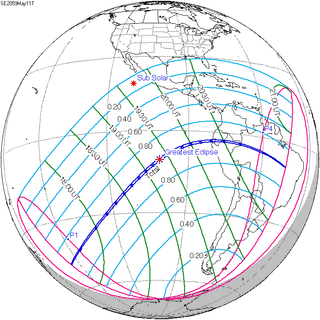| Solar eclipse of May 11, 2059 | |
|---|---|
| Type of eclipse | |
| Nature | Total |
| Gamma | −0.508 |
| Magnitude | 1.0242 |
| Maximum eclipse | |
| Duration | 143 s (2 min 23 s) |
| Coordinates | 10°42′S 100°24′W / 10.7°S 100.4°W |
| Max. width of band | 95 km (59 mi) |
| Times (UTC) | |
| Greatest eclipse | 19:22:16 |
| References | |
| Saros | 129 (54 of 80) |
| Catalog # (SE5000) | 9640 |
A total solar eclipse will occur at the Moon's ascending node of orbit on Sunday, May 11, 2059,[1] with a magnitude of 1.0242. A solar eclipse occurs when the Moon passes between Earth and the Sun, thereby totally or partly obscuring the image of the Sun for a viewer on Earth. A total solar eclipse occurs when the Moon's apparent diameter is larger than the Sun's, blocking all direct sunlight, turning day into darkness. Totality occurs in a narrow path across Earth's surface, with the partial solar eclipse visible over a surrounding region thousands of kilometres wide. Occurring about 3.5 days after perigee (on May 8, 2059, at 7:40 UTC), the Moon's apparent diameter will be larger.[2]
The path of totality will be visible from parts of Ecuador, Peru, extreme southern Colombia, and Brazil. A partial solar eclipse will also be visible for parts of eastern Oceania, South America, Central America, and the Caribbean.
- ^ "May 11, 2059 Total Solar Eclipse". timeanddate. Retrieved 17 August 2024.
- ^ "Moon Distances for London, United Kingdom, England". timeanddate. Retrieved 17 August 2024.
